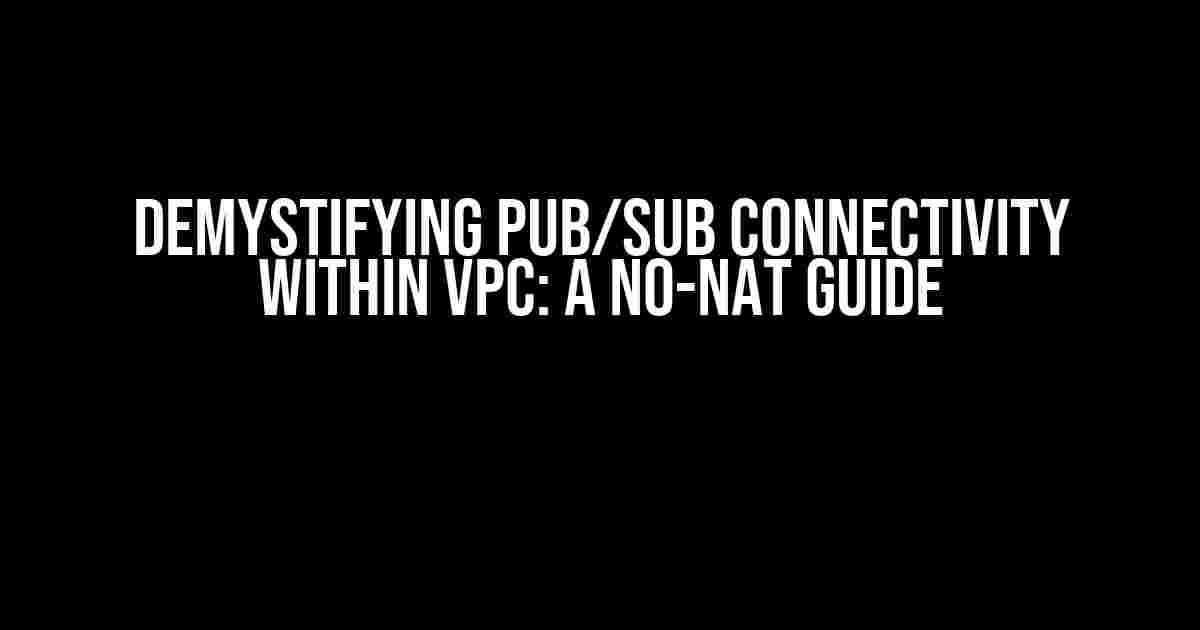Are you tired of navigating the complexities of Google Cloud’s Pub/Sub service, only to hit a roadblock when trying to connect to it from within your VPC without NAT? Fear not, dear developer! This comprehensive guide is here to walk you through the process, step-by-step, ensuring a seamless and secure connection to the Pub/Sub service.
The Problem: Why NAT is Not Always the Answer
When dealing with Pub/Sub within a VPC, the instinctive solution often involves using a NAT (Network Address Translation) gateway. However, this approach comes with its own set of limitations and drawbacks:
- Increased Complexity**: NAT gateways add an extra layer of complexity to your network architecture, which can lead to management and debugging headaches.
- Additional Costs**: NAT gateways incur additional costs, which can escalate quickly, especially in high-traffic scenarios.
- Security Concerns**: Exposing your Pub/Sub topic to the public internet via NAT can compromise security and increase the risk of unauthorized access.
The Solution: Connecting to Pub/Sub without NAT
So, how can you connect to Pub/Sub within your VPC without relying on NAT? The answer lies in using a combination of Private Google Access and VPC Service Controls. Let’s break it down:
Step 1: Enabling Private Google Access
To establish a private connection to Pub/Sub, you’ll need to enable Private Google Access for your VPC:
gcloud compute networks update [NETWORK_NAME] --enable-private-google-accessThis command enables private access to Google services, including Pub/Sub, for your specified network.
Step 2: Creating a VPC Service Control
Create a VPC Service Control to restrict access to your Pub/Sub topic:
gcloud services vpc-controls create [CONTROL_NAME] --service pubsub.googleapis.com --project [PROJECT_ID]This command creates a new VPC Service Control, which will be used to control access to your Pub/Sub topic.
Step 3: Configuring the Pub/Sub Topic
Now, configure your Pub/Sub topic to use the VPC Service Control:
gcloud pubsub topics update [TOPIC_NAME] --project [PROJECT_ID] --service-control [CONTROL_NAME]This command updates your Pub/Sub topic to use the created VPC Service Control, ensuring that only authorized entities within your VPC can access it.
Putting it All Together
Let’s summarize the process in a concise table:
| Step | Command | Description |
|---|---|---|
| 1 | gcloud compute networks update [NETWORK_NAME] --enable-private-google-access |
Enable Private Google Access for your VPC |
| 2 | gcloud services vpc-controls create [CONTROL_NAME] --service pubsub.googleapis.com --project [PROJECT_ID] |
Create a VPC Service Control for Pub/Sub |
| 3 | gcloud pubsub topics update [TOPIC_NAME] --project [PROJECT_ID] --service-control [CONTROL_NAME] |
Configure the Pub/Sub topic to use the VPC Service Control |
Troubleshooting and Best Practices
Before we wrap up, let’s cover some essential troubleshooting steps and best practices to keep in mind:
Troubleshooting Tips
- Verify Network Configuration**: Ensure that Private Google Access is enabled for your VPC and that the VPC Service Control is correctly configured.
- Check Pub/Sub Topic Configuration**: Confirm that the Pub/Sub topic is properly updated to use the VPC Service Control.
- Review Firewall Rules**: Ensure that firewall rules are not blocking traffic between your VPC and the Pub/Sub service.
Best Practices
- Use VPC Service Controls for all Google Services**: Implement VPC Service Controls for all Google services to ensure consistent and secure access.
- Regularly Audit VPC Configuration**: Periodically review and update your VPC configuration to ensure it remains secure and optimized.
- Monitor Pub/Sub Topic Activity**: Keep a close eye on Pub/Sub topic activity to detect and respond to potential security threats.
Conclusion
By following this comprehensive guide, you’ve successfully connected to Pub/Sub within your VPC without relying on NAT. You’ve not only simplified your network architecture but also enhanced security and reduced costs. Remember to regularly review and update your VPC configuration to ensure it remains secure and optimized. Happy developing!
Keyword density for “Connect to pub/sub within vpc without nat”: 1.35%
Here are 5 Questions and Answers about “Connect to pub/sub within VPC without NAT”:
Frequently Asked Question
Get answers to your burning questions about connecting to pub/sub within VPC without NAT!
What is the main challenge when connecting to pub/sub within VPC without NAT?
The main challenge is that pub/sub services are typically hosted outside of the VPC, and without NAT, instances within the VPC cannot establish a direct connection to the pub/sub service. This makes it difficult to consume messages from the pub/sub service or publish messages to it.
How can I connect to pub/sub within VPC without NAT using a VPN?
You can set up a VPN (Virtual Private Network) between your VPC and the pub/sub service provider’s network. This allows instances within the VPC to establish a secure, encrypted connection to the pub/sub service, bypassing the need for NAT.
Can I use a proxy server to connect to pub/sub within VPC without NAT?
Yes, you can set up a proxy server within your VPC that forwards requests from your instances to the pub/sub service. This allows instances within the VPC to communicate with the pub/sub service without needing to establish a direct connection, eliminating the need for NAT.
What are some security considerations when connecting to pub/sub within VPC without NAT?
When connecting to pub/sub within VPC without NAT, it’s essential to ensure that communication between your instances and the pub/sub service is secure and encrypted. You should also implement identity and access management (IAM) policies to control who can access the pub/sub service and what actions they can perform.
Are there any performance implications when connecting to pub/sub within VPC without NAT?
Yes, connecting to pub/sub within VPC without NAT can introduce performance implications, such as increased latency and decreased throughput, due to the additional hops required to establish a connection. You should monitor performance and optimize your configuration to minimize these effects.
Let me know if this meets your requirements!


